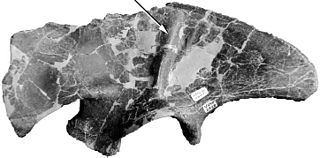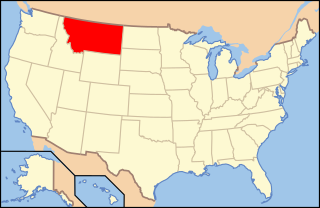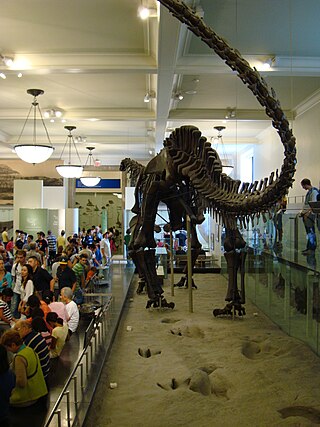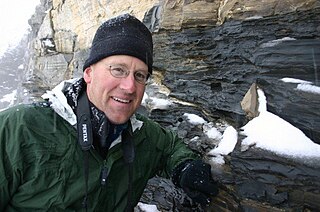
Allosaurus is an extinct genus of large carnosaurian theropod dinosaur that lived 155 to 145 million years ago during the Late Jurassic period. The name "Allosaurus" means "different lizard", alluding to its unique concave vertebrae. It is derived from the Greek words ἄλλος and σαῦρος. The first fossil remains that could definitively be ascribed to this genus were described in 1877 by famed paleontologist Othniel Charles Marsh. As one of the first well-known theropod dinosaurs, it has long attracted attention outside of paleontological circles.

Morrison is a home rule municipality in Jefferson County, Colorado, United States. The population was 396 at the 2020 census.

The Front Range is a mountain range of the Southern Rocky Mountains of North America located in the central portion of the U.S. State of Colorado, and southeastern portion of the U.S. State of Wyoming. It is the first mountain range encountered as one goes westbound along the 40th parallel north across the Great Plains of North America.

Acrocanthosaurus is a genus of carcharodontosaurid dinosaur that existed in what is now North America during the Aptian and early Albian stages of the Early Cretaceous, from 113 to 110 million years ago. Like most dinosaur genera, Acrocanthosaurus contains only a single species, A. atokensis. Its fossil remains are found mainly in the U.S. states of Oklahoma, Texas, and Wyoming, although teeth, a tibia, and vertebrae attributed to Acrocanthosaurus have been found as far east as Maryland, suggesting a continent-wide range.

The Morrison Formation is a distinctive sequence of Upper Jurassic sedimentary rock found in the western United States which has been the most fertile source of dinosaur fossils in North America. It is composed of mudstone, sandstone, siltstone, and limestone and is light gray, greenish gray, or red. Most of the fossils occur in the green siltstone beds and lower sandstones, relics of the rivers and floodplains of the Jurassic period.

Torvosaurus is a genus of large megalosaurine theropod dinosaur that lived approximately 165 to 148 million years ago during the Callovian to Tithonian ages of the late Middle and Late Jurassic period in what is now Colorado, Portugal, Germany, and possibly England, Spain, Tanzania, and Uruguay. It contains two currently recognized species, Torvosaurus tanneri and Torvosaurus gurneyi, plus a third unnamed species from Germany.

The Denver Basin, variously referred to as the Julesburg Basin, Denver-Julesburg Basin, or the D-J Basin, is a geologic structural basin centered in eastern Colorado in the United States, but extending into southeast Wyoming, western Nebraska, and western Kansas. It underlies the Denver-Aurora Metropolitan Area on the eastern side of the Rocky Mountains.

The Dakota Hogback is a long hogback ridge at the eastern fringe of the Rocky Mountains that extends north-south from southern Wyoming through Colorado and into northern New Mexico in the United States. The ridge is prominently visible as the first line of foothills along the edge of the Great Plains. It is generally faulted along its western side, and varies in height, with gaps in numerous locations where rivers exit the mountains. The ridge takes its name from the Dakota Formation, a formation with resistant sandstone beds that cap the ridge. The hogback was formed during the Laramide orogeny, approximately 50 million years ago, when the modern Rockies were created. The general uplift to the west created long faulting in the North American Plate, resulting in the creation of the hogback.

Saurophaganax, also known as Allosaurus maximus or Saurophagus maximus, is a genus of large allosaurid dinosaur from the Morrison Formation of Late Jurassic Oklahoma, United States. Some paleontologists consider it to be a junior synonym and species of Allosaurus. Saurophaganax represents a very large Morrison allosaurid characterized by horizontal laminae at the bases of the dorsal neural spines above the transverse processes, and "meat-chopper" chevrons. It was the largest terrestrial carnivore of North America during the Late Jurassic, reaching 10.5 metres (34 ft) in length and 2.7–3.8 metric tons in body mass.

Stokesosaurus is a genus of small, carnivorous early tyrannosauroid theropod dinosaurs from the late Jurassic period of Utah, United States.

Marshosaurus is a genus of medium-sized carnivorous theropod dinosaur, belonging to the Megalosauroidea, from the Late Jurassic Morrison Formation of Utah and possibly Colorado.

In geology and geomorphology, a hogback or hog's back is a long, narrow ridge or a series of hills with a narrow crest and steep slopes of nearly equal inclination on both flanks. Typically, the term is restricted to a ridge created by the differential erosion of outcropping, steeply dipping, homoclinal, and typically sedimentary strata. One side of a hogback consists of the surface of a steeply dipping rock stratum called a dip slope. The other side is an erosion face that cuts through the dipping strata that comprises the hogback. The name "hogback" comes from the Hog's Back of the North Downs in Surrey, England, which refers to the landform's resemblance in outline to the back of a hog. The term is also sometimes applied to drumlins and, in Maine, to both eskers and ridges known as "horsebacks".
The Cedar Mountain Formation is the name given to a distinctive sedimentary geologic formation in eastern Utah, spanning most of the early and mid-Cretaceous. The formation was named for Cedar Mountain in northern Emery County, Utah, where William Lee Stokes first studied the exposures in 1944.

The Dakota is a sedimentary geologic unit name of formation and group rank in Midwestern North America. The Dakota units are generally composed of sandstones, mudstones, clays, and shales deposited in the Mid-Cretaceous opening of the Western Interior Seaway. The usage of the name Dakota for this particular Albian-Cenomanian strata is exceptionally widespread; from British Columbia and Alberta to Montana and Wisconsin to Colorado and Kansas to Utah and Arizona. It is famous for producing massive colorful rock formations in the Rocky Mountains and the Great Plains of the United States, and for preserving both dinosaur footprints and early deciduous tree leaves.

Martin G. Lockley was a Welsh palaeontologist. He was educated in the United Kingdom where he obtained degrees and post-doctoral experience in Geology in the 1970s. Since 1980 he had been a professor at the University of Colorado at Denver, (UCD) and was later Professor Emeritus. He is best known for his work on fossil footprints and was the former director of the Dinosaur Tracks Museum at UCD. He was an Associate Curator at the University of Colorado Museum of Natural History and Research Associate at the Denver Museum of Nature and Science. During his years at UCD he earned a BA in 2007 in Spanish with a minor in Religious Studies, became a member of the Scientific and Medical Network and taught and published on the evolution of consciousness.

Paleontology in Montana refers to paleontological research occurring within or conducted by people from the U.S. state of Montana. The fossil record in Montana stretches all the way back to the Precambrian. During the Late Precambrian, western Montana was covered by a warm, shallow sea where local bacteria formed stromatolites and bottom-dwelling marine life left tracks on the sediment that would later fossilize. This sea remained in place during the early Paleozoic, although withdrew during the Silurian and Early Devonian, leaving a gap in the local rock record until its return. This sea was home to creatures including brachiopods, conodonts, crinoids, fish, and trilobites. During the Carboniferous the state was home to an unusual cartilaginous fish fauna. Later in the Paleozoic the sea began to withdraw, but with a brief return during the Permian.

Paleontology in Colorado refers to paleontological research occurring within or conducted by people from the U.S. state of Colorado. The geologic column of Colorado spans about one third of Earth's history. Fossils can be found almost everywhere in the state but are not evenly distributed among all the ages of the state's rocks. During the early Paleozoic, Colorado was covered by a warm shallow sea that would come to be home to creatures like brachiopods, conodonts, ostracoderms, sharks and trilobites. This sea withdrew from the state between the Silurian and early Devonian leaving a gap in the local rock record. It returned during the Carboniferous. Areas of the state not submerged were richly vegetated and inhabited by amphibians that left behind footprints that would later fossilize. During the Permian, the sea withdrew and alluvial fans and sand dunes spread across the state. Many trace fossils are known from these deposits.

Paleontology in Utah refers to paleontological research occurring within or conducted by people from the U.S. state of Utah. Utah has a rich fossil record spanning almost all of the geologic column. During the Precambrian, the area of northeastern Utah now occupied by the Uinta Mountains was a shallow sea which was home to simple microorganisms. During the early Paleozoic Utah was still largely covered in seawater. The state's Paleozoic seas would come to be home to creatures like brachiopods, fishes, and trilobites. During the Permian the state came to resemble the Sahara desert and was home to amphibians, early relatives of mammals, and reptiles. During the Triassic about half of the state was covered by a sea home to creatures like the cephalopod Meekoceras, while dinosaurs whose footprints would later fossilize roamed the forests on land. Sand dunes returned during the Early Jurassic. During the Cretaceous the state was covered by the sea for the last time. The sea gave way to a complex of lakes during the Cenozoic era. Later, these lakes dissipated and the state was home to short-faced bears, bison, musk oxen, saber teeth, and giant ground sloths. Local Native Americans devised myths to explain fossils. Formally trained scientists have been aware of local fossils since at least the late 19th century. Major local finds include the bonebeds of Dinosaur National Monument. The Jurassic dinosaur Allosaurus fragilis is the Utah state fossil.

The 20th century in ichnology refers to advances made between the years 1900 and 1999 in the scientific study of trace fossils, the preserved record of the behavior and physiological processes of ancient life forms, especially fossil footprints. Significant fossil trackway discoveries began almost immediately after the start of the 20th century with the 1900 discovery at Ipolytarnoc, Hungary of a wide variety of bird and mammal footprints left behind during the early Miocene. Not long after, fossil Iguanodon footprints were discovered in Sussex, England, a discovery that probably served as the inspiration for Sir Arthur Conan Doyle's The Lost World.

John Russell Foster is an American paleontologist. Foster has worked with dinosaur remains from the Late Jurassic of the Colorado Plateau and Rocky Mountains, Foster is also working on Cambrian age trilobite faunas in the southwest region of the American west. He named the crocodyliform trace fossil Hatcherichnus sanjuanensis in 1997 and identified the first known occurrence of the theropod trace fossil Hispanosauropus in North America in 2015.

























